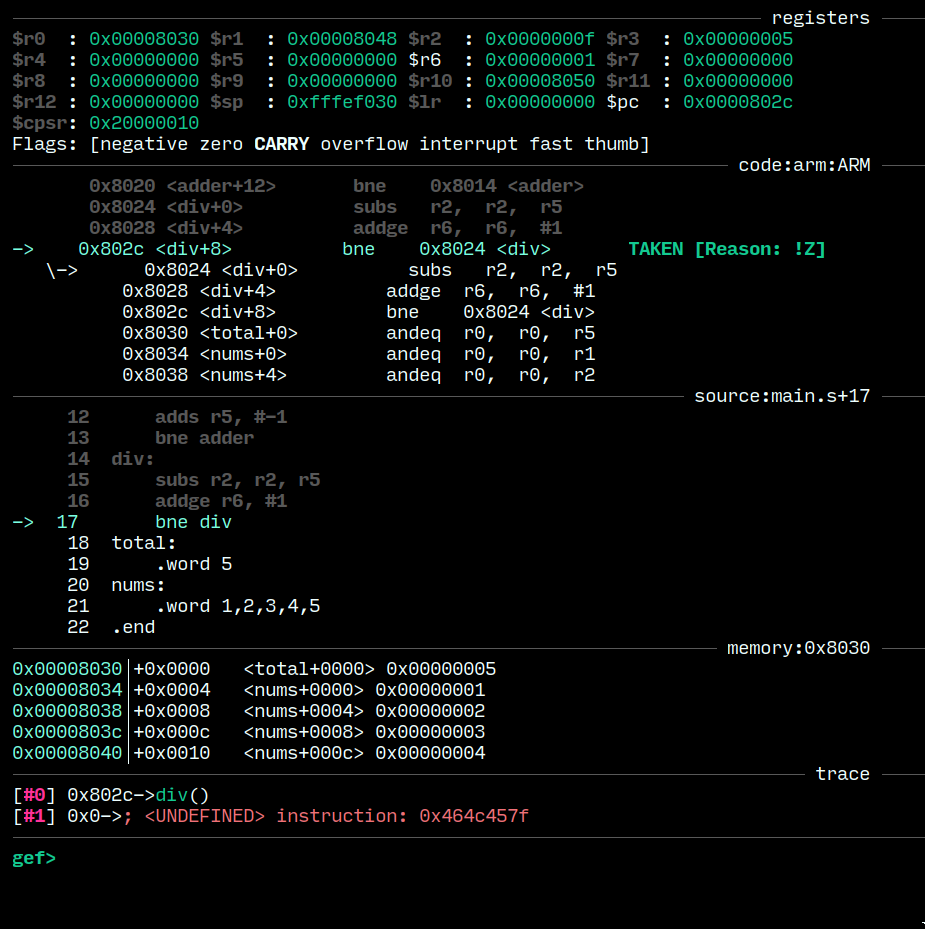diff options
Diffstat (limited to 'posts')
| -rw-r--r-- | posts/call_to_ARMs.md | 84 |
1 files changed, 84 insertions, 0 deletions
diff --git a/posts/call_to_ARMs.md b/posts/call_to_ARMs.md new file mode 100644 index 0000000..c4ce60a --- /dev/null +++ b/posts/call_to_ARMs.md | |||
| @@ -0,0 +1,84 @@ | |||
| 1 | My 4th semester involves ARM programming. And proprietary | ||
| 2 | tooling (Keil C). But we don't do that here. | ||
| 3 | |||
| 4 | ### Building | ||
| 5 | |||
| 6 | Assembling and linking ARM binaries on non-ARM architecture | ||
| 7 | devices is fairly trivial. I went along with the GNU cross | ||
| 8 | bare metal toolchain binutils, which provides `arm-as` and | ||
| 9 | `arm-ld` (among a bunch of other utils that I don't care | ||
| 10 | about for now). | ||
| 11 | |||
| 12 | Assemble `.s` files with: | ||
| 13 | |||
| 14 | ```shell | ||
| 15 | arm-none-eabi-as main.s -g -march=armv8.1-a -o main.out | ||
| 16 | ``` | ||
| 17 | |||
| 18 | The `-g` flag generates extra debugging information that | ||
| 19 | `gdb` picks up. The `-march` option establishes target | ||
| 20 | architecture. | ||
| 21 | |||
| 22 | Link `.o` files with: | ||
| 23 | |||
| 24 | ```shell | ||
| 25 | arm-none-eabi-ld main.out -o main | ||
| 26 | ``` | ||
| 27 | |||
| 28 | ### Running (and Debugging) | ||
| 29 | |||
| 30 | Things get interesting here. `gdb` on your x86 machine | ||
| 31 | cannot read nor execute binaries compiled for ARM. So, we | ||
| 32 | simulate an ARM processor using `qemu`. Now qemu allows you | ||
| 33 | to run `gdbserver` on startup. Connecting our local `gdb` | ||
| 34 | instance to `gdbserver` gives us a view into the program's | ||
| 35 | execution. Easy! | ||
| 36 | |||
| 37 | Run `qemu`, with `gdbserver` on port `1234`, with our ARM | ||
| 38 | binary, `main`: | ||
| 39 | |||
| 40 | ```shell | ||
| 41 | qemu-arm -singlestep -g 1234 main | ||
| 42 | ``` | ||
| 43 | |||
| 44 | Start up `gdb` on your machine, and connect to `qemu`'s | ||
| 45 | `gdbserver`: | ||
| 46 | |||
| 47 | ``` | ||
| 48 | (gdb) set architecture armv8-a | ||
| 49 | (gdb) target remote localhost:1234 | ||
| 50 | (gdb) file main | ||
| 51 | Reading symbols from main... # yay! | ||
| 52 | ``` | ||
| 53 | |||
| 54 | ### GDB Enhanced | ||
| 55 | |||
| 56 | `gdb` is cool, but it's not nearly as comfortable as well | ||
| 57 | fleshed out emulators/IDEs like Keil. Watching registers, | ||
| 58 | CPSR and memory chunks update *is* pretty fun. | ||
| 59 | |||
| 60 | I came across `gdb`'s TUI mode (hit `C-x C-a` or type `tui | ||
| 61 | enable` at the prompt). TUI mode is a godsend. It highlights | ||
| 62 | the current line of execution, shows you disassembly | ||
| 63 | outputs, updated registers, active breakpoints and more. | ||
| 64 | |||
| 65 | *But*, it is an absolute eyesore. | ||
| 66 | |||
| 67 | Say hello to [GEF](https://github.com/hugsy/gef)! "GDB | ||
| 68 | Enhanced Features" teaches our old dog some cool new tricks. | ||
| 69 | Here are some additions that made my ARM debugging | ||
| 70 | experience loads better: | ||
| 71 | |||
| 72 | - Memory watches | ||
| 73 | - Register watches, with up to 7 levels of deref (overkill, | ||
| 74 | I agree) | ||
| 75 | - Stack tracing | ||
| 76 | |||
| 77 | And its pretty! See for yourself: | ||
| 78 | |||
| 79 |  | ||
| 80 | |||
| 81 | ### Editing | ||
| 82 | |||
| 83 | Vim, with `syntax off` because it | ||
| 84 | dosen't handle GNU ARM syntax too well. | ||
